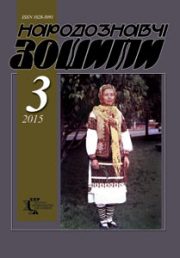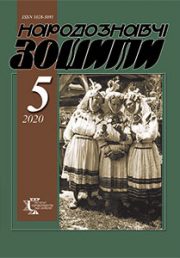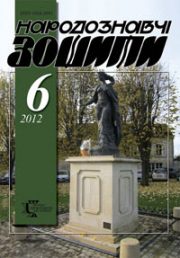The Ethnology Notebooks. 2021. # 1 (157), P. 73—83
УДК 398.3:664.6( 477.87-2=161.2)
DOI https://doi.org/10.15407/nz2021.01.073
Andrii ZIUBROVSKYI
- ORCID ID: https://orcid.org/0000-0002-2221-3731
- Candidate of Sciences in History,
- Senior Researcher,
- the Institute of Ethnology of the National
- Academy of Sciences of Ukraine,
- the Department of Historical Ethnology,
- 15, Svobody Avenue, 79000, Lviv, Ukraine,
- e-mail: anzjubr@gmail.com
The stage of heat treatment of the dough, which began with the insertion of bread into the oven, was one of the most important in the process of baking bread. It was at this stage that inedible dough became bread, changing not only visually but also conceptually. During this stage, the hostess could hardly have any real influence on the preparation of cookies, as the main factors of successful baking were laid down in advance.
Despite the importance of this stage of the baking cycle, this topic is extremely poorly covered, both in the literature sources and in scientific studies related to folk nutrition. Thus, in Ukrainian ethnology there is still no work devoted to determining the realistic basis (or lack thereof) in folk conceptions about the markers of the oven’s readiness to bake bread, there is no correlation of peasants’ ideas with modern scientific data. The object of this article is the stage of checking the readiness of the oven for planting bread, and the subject — specific criteria, methods, ways and markers for determining the temperature of the working surfaces and the inner space of the furnace chamber, their types, kinds and origins.
According to folk criteria, the temperature of the stove bottom should not exceed 270—300 degrees and 350—400°C for the walls, the core — no more than 300° C. In principle, these indicators are correlated with modern standards of industrial baking. The polyvalence of the criteria and markers for determining the optimal temperature is related to the following factors. Thus, flour of different grades and types had different particle size, different amount of impurities, different humidity, and therefore had a slightly different self ignition temperature. The same applies to the dough of different types of cereals: for the successful baking of rye bread required a higher temperature. Each oven had an individual cooling time, so the starting temperature of the beginning of baking was selected and checked by each housewife for a long time of empirical observations. A striking local feature of baking in ethnographic Volyn was the use of table salt as a marker of the oven’s readiness to plant bread. However, it was most likely used for ritual rather than rational purposes.
Keywords: bread, oven, heat, firewood, burnt, sparks, smoke, flour, raw, straw, paper, kotsiuba.
REFERENCES
- Rokossowska, Z. (1899). Bread. Its significance in the world conceptions, the healing and the daily life, gathered in the village Yurkovszczyzna Zwiahel district. Wisla (Vol.13, pp. 153–158) [in Polish].
- Shchelokovskaia, V. (1899). Food and drink of peasants-maloros`, with some customs, beliefs and omens related here. Etnohraphicheskoie obozreniie, 1—2, 266—322 [in Russian].
- Zahlada, N. (1931). Food in the village Starosillia in Chernihiv region. Materiialy do ethnolohii. Materials for the monograph village Starosillia (Vol. 3, pp. 83—196) [in Ukrainian].
- Konenko, Y. (1918). Folk food in Skalat district. Materiialy do Ukrainskoi etnologii (Vol. 28, pp. 70—85) [in Ukrainian].
- Artiukh, L. (1977). Ukrainian folk cooking [in Ukrainian].
- Tsypyshev, S. (2009). Traditional bread products of Rivne Polissya in the early twentieth century. (According to field materials from Dubrovytsia and Sarny districts of Rivne region). Polissieznavstvo in folklore-ethnographic and literary-artistic researches: Scientific edition (Pp. 99—107) [in Ukrainian].
- Ziubrovskyi, A. (2018). Folk traditions of baking bread of Ukrainians in the late XIX — early XXI century (According to the data South-Western historic-ethnographic macro region of Ukraine). Kyiv [in Ukrainian].
- Konopka, V., & Ziubrovskyi, A. (2018). «From grain to bread»: semantic-structural analysis of Ukrainians’ agricultural way of life (on the data of the South-Western historic-ethnographic macro region). Lviv [in Ukrainian].
- Ziubrovskyi, A. (2010). Traditional basis of baking bread in Rivne region (according to field research of Hoshcha and Ostroh districts of Rivne region in July 2009). The Ethnology Notebooks, 5—6, 776–783 [in Ukrainian].
- Archive of the Institute of Ethnology of the National Academy of Sciences of Ukraine (hereinafter: Archive of IE NASU). F. 1. Op. 2. Act. 598-a. Field ethnographic materials on the topic «Bread in the traditional culture of Ukrainians», recorded by Andrii Viktorovych Ziubrovskyi on July 4—10, 2009 in Hoscha and Ostroh districts of Rivne region [in Ukrainian].
- Archive of IE NASU. F. 1. Op. 2. Act. 683: Field ethnographic materials on the topic «Bread in the traditional culture of Ukrainians» were recorded by Andrii Viktorovych Ziubrovskyi on June 2—5, 2010 in Shumsk district of Ternopil region [in Ukrainian].
- Archive of IE NASU. F. 1. Op. 2. Act. 685: Field ethnographic materials on the topic «Bread in the traditional culture of Ukrainians» were recorded by Andrii Viktorovych Ziubrovskyi on July 7—19, 2010 in the Horokhiv district of the Volyn region [in Ukrainian].
- Archive of IE NASU. F. 1. Op. 2. Act. 686: Field ethnographic materials on the topic «Bread in the traditional culture of Ukrainians» were recorded by Andrii Viktorovych Ziubrovskyi on August 27—29, 2010 in Zdolbuniv district of Rivne region [in Ukrainian].
- Archive of IE NASU. F. 1. Op. 2. Act. 688: Field ethnographic materials on the topic «Bread in the traditional culture of Ukrainians» were recorded by Andrii Viktorovych Ziubrovskyi on July 7—13, 2011 in Brody and Radekhiv districts of Lviv region [in Ukrainian].
- Archive of IE NASU. F. 1. Op. 2. Act. 689: Field ethnographic materials on the topic «Bread in the traditional culture of Ukrainians», recorded by Andrii Viktorovych Ziubrovskyi on July 4—8, 2012 in Kamianka-Buzka district of Lviv region [in Ukrainian].
- Holubovych, I. (1918). Folk food in Sniatyn district (Pokuttia). Materiialy do Ukrainskoi etnologii (Vol. 28, pp. 48—70). Lviv [in Ukrainian].
- Guzman, I. (Ed.). (2003). Chemical technology of ceramics. Textbook. Manual for universities [in Russian].
- Drobot, V. (2002). Bakery production technology. Kyiv [in Ukrainian].
- Kravchenko, V., & Ruban, O. (Ed.). (2009). Fire. In Collection of works and materials on archival heritage (Vol. 2, p. 70). Kyiv [in Ukrainian].
- Makhovskyi, V., & Kriukovska, O. (2105). Research of dangers and an estimation of consequences of emergency situations and accidents in warehouses of bulk storage of flour of the bakery enterprises. Collection of Dniprodzerzhynsk State Technical University, 1, 288–295 [in Ukrainian].
- Archive of IE NASU. F. 1. Op. 2, Act. 684: Field ethnographic materials on the topic «Bread in the traditional culture of Ukrainians» were recorded by Andrii Viktorovych Ziubrovskyi on June 27—29, 2010 in Turkiv district of Lviv region [in Ukrainian].
- Archive of IE NASU. F. 1. Op. 2. Act. 687: Field ethnographic materials on the topic «Bread in the traditional culture of Ukrainians» were recorded by Andrii Viktorovych Ziubrovskyi on June 22—25, 2011 in Volovets district of Zakarpattia region [in Ukrainian].
- Aftandyliants, E., Zazymko, O., & Lopatko, K. (2013). Materials of science. Kyiv [in Ukrainian].
- Piankova, K., Sedakova, I., & Tolstoi, N. (Ed.). (2012). Salt. Slavic antiquities: Ethnolinguistic dictionary: in 5 vol. (Vol. 5, pp. 113—119). Moscow [in Russian].
- Archive of IE NASU. F. 1. Op. 2. Act. 791: Field ethnographic materials on the topic «Bread in the traditional culture of Ukrainians», recorded by Andrii Viktorovych Ziubrovskyi on July 3—13, 2013 in Chernyakhiv, Chervonoarmiisk and Novograd-Volynsk districts of Zhytomyr region [in Ukrainian].
- Baran, D., & Khomovsky, O. (2019). Features of burning of wooden structures. Collection of abstracts of the 8th International Scientific and Technical Conference of Young Scientists and Students «Actual problems of modern technologies», November 27—28, 2019 (Vol. 1, p. 143) [in Ukrainian].
- Mandebura, O., Pavlyuk, S., & Omelyashko, R. (Eds.). (2003). Traditional Polissia nutrition: everyday food. Polissia Ukrainy: materialy istoryko-etnografichnoho doslidzhennia. In the interfluve of the Uzh and Teterev rivers. 1996 (Issue 3, pp. 323—336). Lviv [in Ukrainian].







